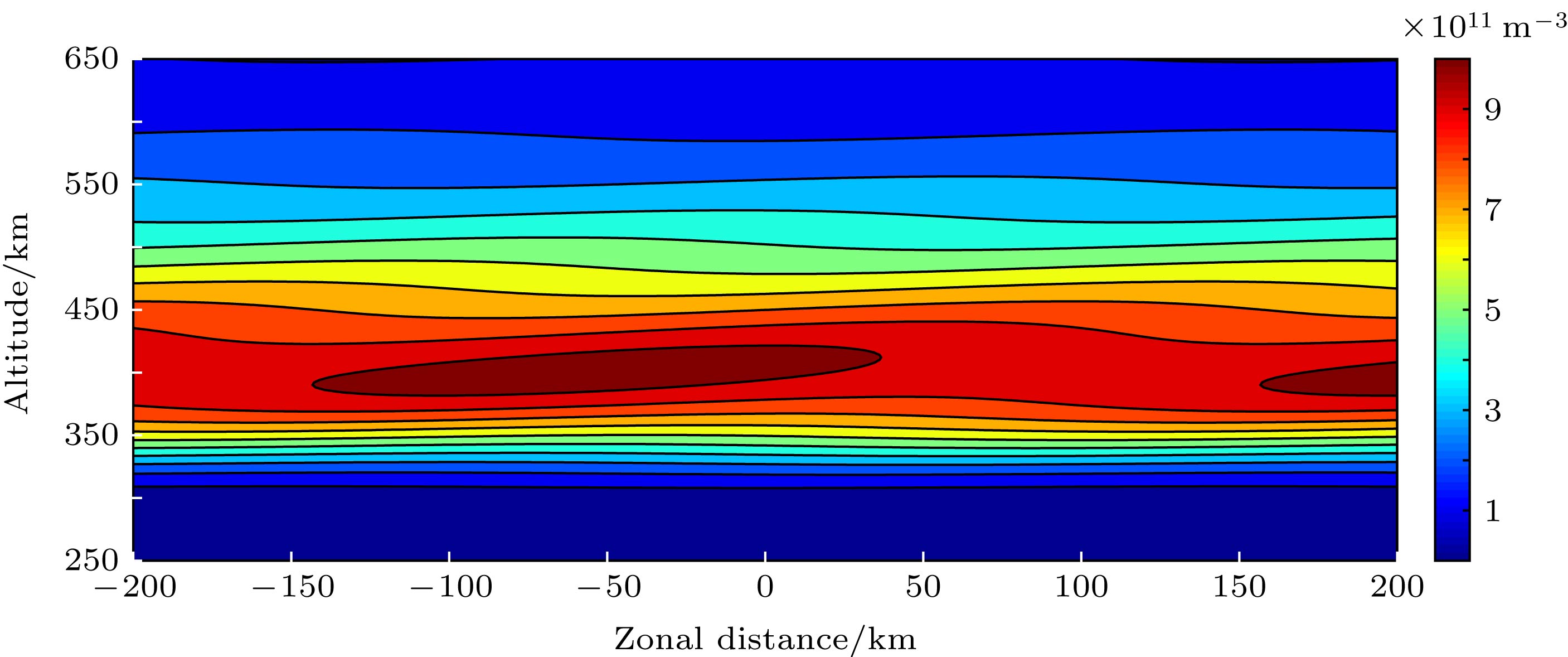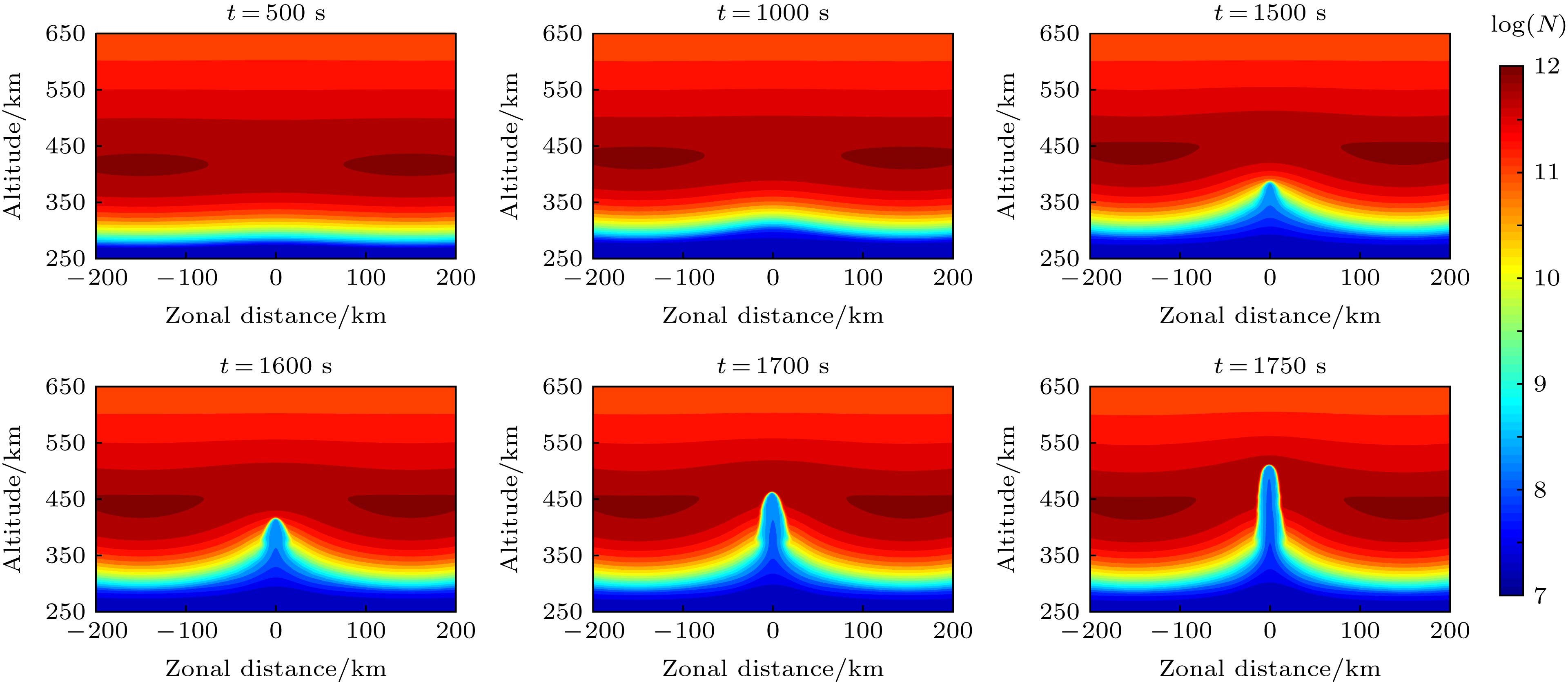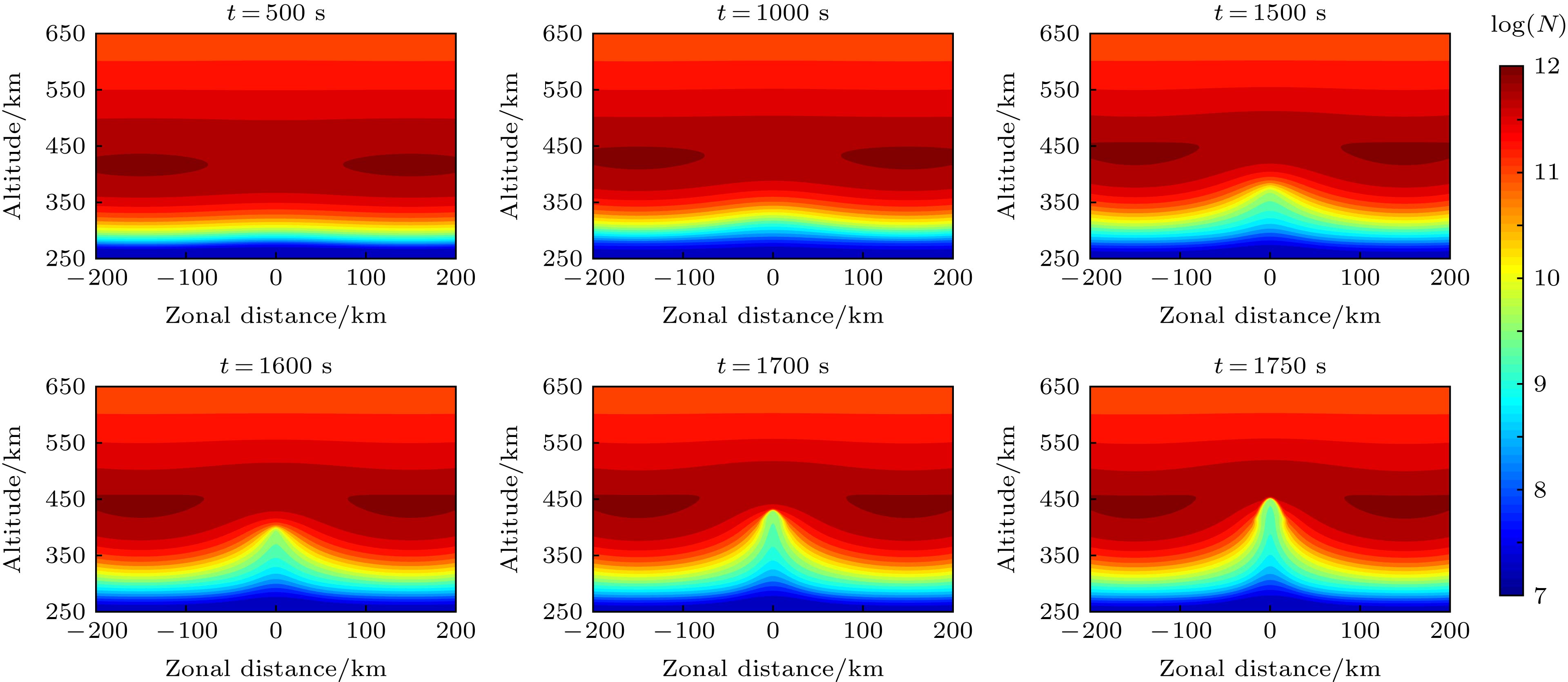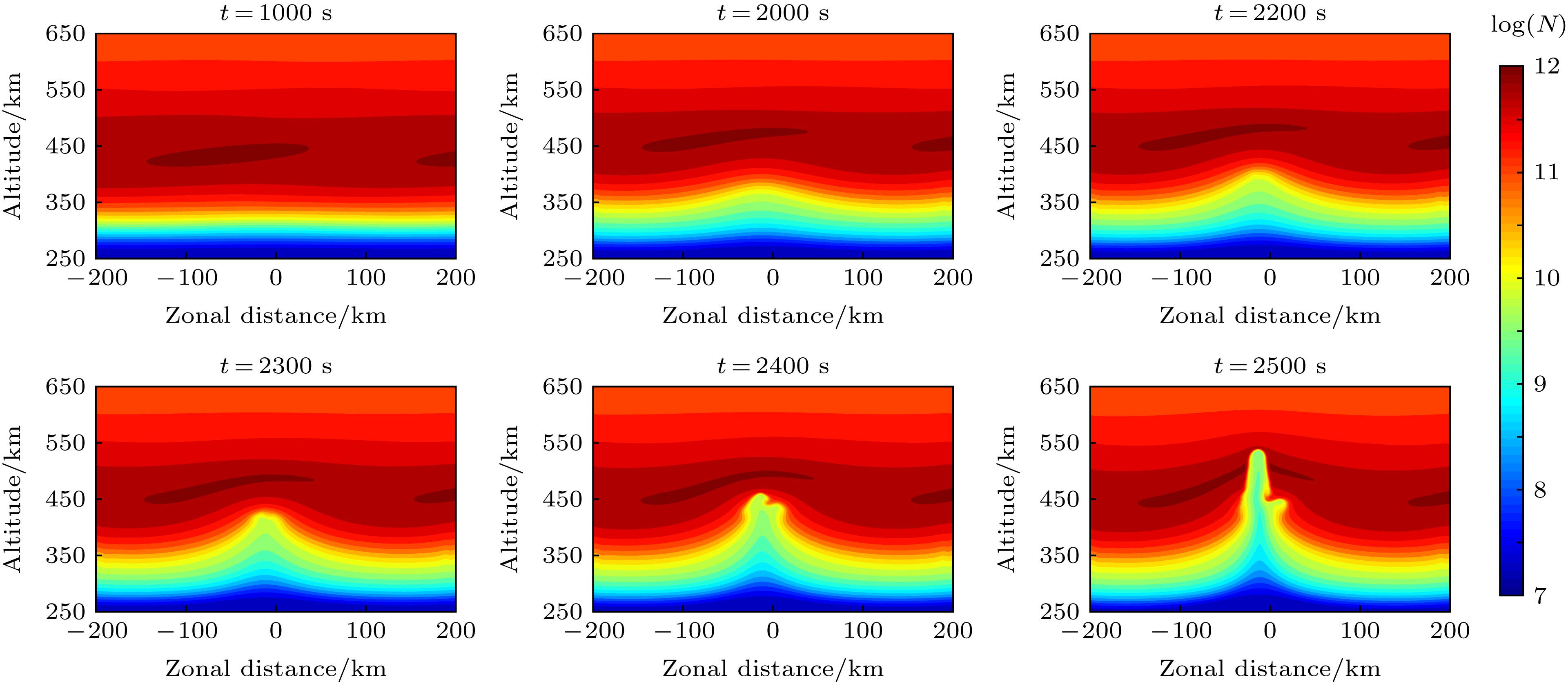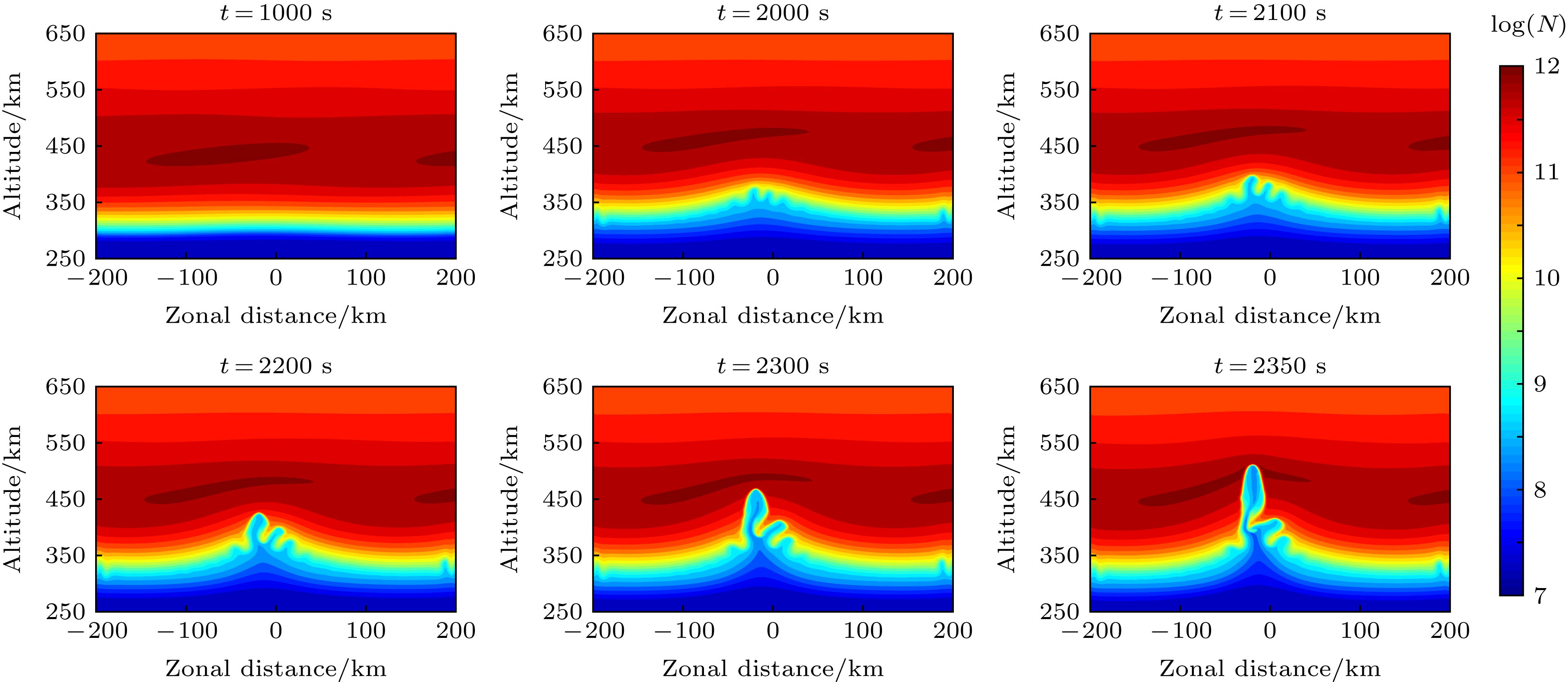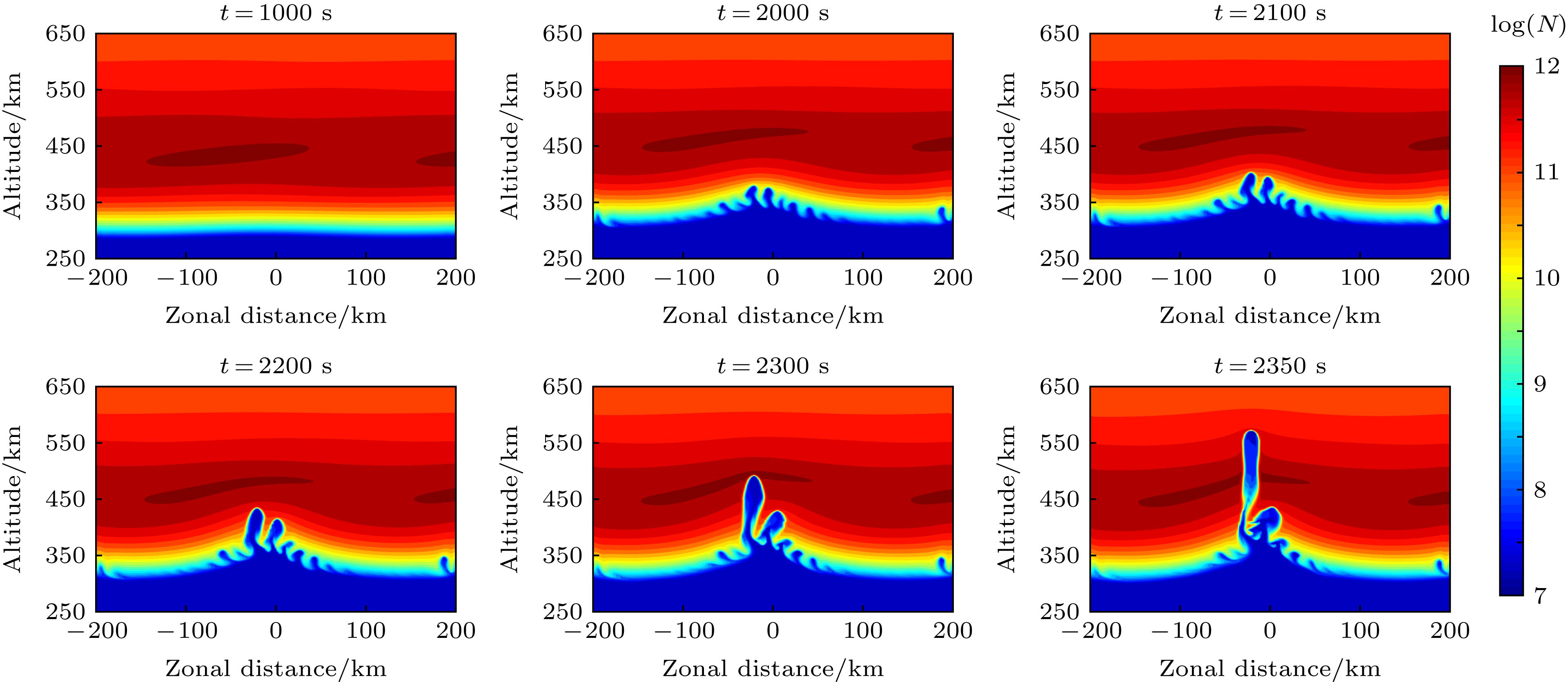-
本文模拟研究了背景电离层在一维和二维扰动下产生等离子体泡的过程, 在模拟过程中引入行进式电离层扰动(traveling ionosphere disturbances, TIDs)模型激发生成电子密度的二维扰动, 同时通过改变化学复合率来研究不同复合率对等离子体泡结构形态的影响. 模拟结果表明, 复合率对等离子体泡的生成速度有较大影响, 复合率越大, 激发等离子体泡所需时间越长. 另外, 在二维扰动情况下电离层生成等离子体泡的速度要比一维扰动情况下的速度慢. 在一维扰动情况下, 不同复合率对等离子体泡结构形态影响不大, 而在TIDs激发的等离子体泡中, 不同复合率对等离子体泡的结构形态有较大影响. 在较小复合率的情况下, TIDs激发的等离子体泡可以产生分叉结构, 并伴有大量小尺度的等离子体泡结构, 同时模拟结果存在等离子体泡底部收缩现象. 模拟结果还表明, 当存在大量小尺度等离子体泡时, 单个等离子体泡周围的极化电场方向在非线性的演化过程中可能会发生变化, 因此并不是所有底部等离子体泡都能够抬升到电离层顶部, 只有其周围极化电场方向一直是东向的等离子体泡, 才能够进一步抬升到电离层顶部.Plasma bubbles in the ionosphere have a significant effect on radio wave communication and navigation. Under the worst condition, it will fail to function the systems relying on the ionosphere. On the other hand, the physical mechanisms of evolution and diurnal variations of the plasma bubbles in the ionosphere are still unclear. Therefore, it is still worthy to simulate the plasma bubbles in the ionosphere for radio wave propagation and science. In this study, the equatorial plasma bubbles induced by one- and two- dimensional disturbance in the ionosphere are simulated, where traveling ionospheric disturbance (TID) is used to produce the two-dimensional disturbance in the ionosphere. The dispersion relationship of gravity wave is used to represent the corresponding wavelength of TID in this study. More importantly, we investigate the effect of recombination rate on the development of plasma bubbles by numerical simulation. The simulation results show that the recombination rate of the plasma in the ionosphere has a significant effect on the development of plasma bubbles. The greater the recombination rate, the more time it takes to produce the plasma bubbles. For one-dimensional disturbance in the ionosphere, there is no significant effect in the structure of plasma bubbles for the recombination rate of the plasma. However, the recombination rate plays a significant effect on the structure of plasma bubbles induced by TID. When the recombination rate is less in numerical simulation, the complex structure including bifurcation, plume-like structures, and pinching of plasma bubbles can occur in the development of bubbles. In contrast, the structure of plasma bubbles is simpler when the recombination rate is greater in simulation. As a result, the recombination rate of the plasma is a significant factor for simulating the plasma bubbles in the ionosphere. The greater recombination rate can result in the slowing down of equatorial plasma bubbles and the simplifying the structure of the bubbles as well. In addition, it is found that not all of plasma bubbles at the bottom of the ionosphere can grow to the top of the ionosphere when many bubbles occur on the bottom side. The direction of the polarization electric field near the bubbles can be changed in the non-linear development of the bubbles. Therefore, only the bubbles where the polarization electric field is always eastward can develop to the topside.
-
Keywords:
- chemical recombination rate /
- equatorial plasma bubble /
- travelling ionospheric disturbances /
- numerical simulation
[1] Dungey J W 1956 J. Atmos. Terr. Phys. 9 304
 Google Scholar
Google Scholar
[2] Abdu M A 2001 J. Atmos. Terr. Phys. 63 869
 Google Scholar
Google Scholar
[3] Tsunoda R T, Yamamoto M, Tsugawa T, Hoang T L, Ram S T, Thampi S V, Chau H D, Nagatsuma T 2011 Geophys. Res. Lett. 38 L20102
 Google Scholar
Google Scholar
[4] Sekar R, Suhasini R, Raghavarao R 1994 J. Geophys. Res. 99 2205
 Google Scholar
Google Scholar
[5] Huang C S, Kelley M C 1996 J. Geophys. Res. Space Physics 101 303
 Google Scholar
Google Scholar
[6] Hysell D L, Kelley M C, Swartz W E, Woodman R F 1990 J. Geophys. Res. Space Physics 95 17253
 Google Scholar
Google Scholar
[7] Huang C S, Kelley M C 1996 J. Geophys. Res. Space Physics 101 293
 Google Scholar
Google Scholar
[8] Scannapieco A J, Ossakow S L 1976 Geophys. Res. Lett. 3 451
 Google Scholar
Google Scholar
[9] Zalesak S T, Ossakow S L 1980 J. Geophys. Res. 85 2131
 Google Scholar
Google Scholar
[10] Zalesak S T, Ossakow S L, Chaturvedi P K 1982 J. Geophys. Res. 87 151
 Google Scholar
Google Scholar
[11] 谢红, 肖佐 1993 地球物理学报 36 18
 Google Scholar
Google Scholar
Xie H, Xiao Z 1993 Chinese J. Geophys. 36 18
 Google Scholar
Google Scholar
[12] 高泽, 方涵先, 汪四成, 杨升高 2017 地球物理学报 60 470
 Google Scholar
Google Scholar
Gao Z, Fang H X, Wang S C, Yang S G 2017 Chinese J. Geophys. 60 470
 Google Scholar
Google Scholar
[13] Huba J D, Joyce G, Krall J 2008 Geophys. Res. Lett. 35 10102
 Google Scholar
Google Scholar
[14] Yokoyama T, Shinagawa H, Jin H 2014 J. Geophys. Res. Space Physics 119 10474
[15] Yokoyama T 2017 Prog. in Earth and Planet. Sci. 4 37
 Google Scholar
Google Scholar
[16] Krall J, Huba J D, Ossakow S L, Joyce G, Makela J J, Miller E S, Kelley M C 2011 Geophys. Res. Lett. 38 L08103
[17] Krall J, Huba J D, Fritts D C 2013 Geophys. Res. Lett. 40 661
 Google Scholar
Google Scholar
[18] Hines C O 1960 Can. J. Phys. 38 1441
 Google Scholar
Google Scholar
[19] Alfonsi L, Spogli L, Pezzopane M, Romano V, Zuccheretti E, De Franceschi G, Cabrera M A, Ezquer R G 2013 J. Geophys. Res. Space Physics 118 4483
 Google Scholar
Google Scholar
[20] Jiang C, Yang G, Deng C, Zhou C, Zhu P, Yokoyama T, Song H, Lan T, Ni B, Zhao Z, Zhang Y 2015 J. Geophys. Res. Space Physics 120 10979
 Google Scholar
Google Scholar
[21] Jiang C, Yang G, Liu J, Zhao Z 2019 J. Geophys. Res. Space Physics 124 1317
 Google Scholar
Google Scholar
[22] Sultan P J 1996 J. Geophys. Res. 101 26875
 Google Scholar
Google Scholar
[23] Kelley M C 2009 Introduction to Spatial Econometrics (2nd ed.), (Amsterdams: Elsevier) p 99
[24] Lanchester B S, Nygren T, Jarvis M J, Edwards R 1993 Ann. Geophys. 11 925
[25] Miyoshi Y, Jin H, Fujiwara H, Shinagawa H 2018 J. Geophys. Res. Space Physics 123 2141
[26] Abdu M A, Batista I S, Kantor I J, Sobral J H A 1982 J. Atmos. Terr. Phys. 44 759
 Google Scholar
Google Scholar
[27] Fukumitsu K, Yabe T, Ogata Y, Oami T, Ohkubo T 2015 J. Comput. Phys. 286 62
 Google Scholar
Google Scholar
[28] Yokoyama T, Jin H, Shinagawa H 2015 J. Geophys. Res. Space Physics 120 8810
 Google Scholar
Google Scholar
-
-
[1] Dungey J W 1956 J. Atmos. Terr. Phys. 9 304
 Google Scholar
Google Scholar
[2] Abdu M A 2001 J. Atmos. Terr. Phys. 63 869
 Google Scholar
Google Scholar
[3] Tsunoda R T, Yamamoto M, Tsugawa T, Hoang T L, Ram S T, Thampi S V, Chau H D, Nagatsuma T 2011 Geophys. Res. Lett. 38 L20102
 Google Scholar
Google Scholar
[4] Sekar R, Suhasini R, Raghavarao R 1994 J. Geophys. Res. 99 2205
 Google Scholar
Google Scholar
[5] Huang C S, Kelley M C 1996 J. Geophys. Res. Space Physics 101 303
 Google Scholar
Google Scholar
[6] Hysell D L, Kelley M C, Swartz W E, Woodman R F 1990 J. Geophys. Res. Space Physics 95 17253
 Google Scholar
Google Scholar
[7] Huang C S, Kelley M C 1996 J. Geophys. Res. Space Physics 101 293
 Google Scholar
Google Scholar
[8] Scannapieco A J, Ossakow S L 1976 Geophys. Res. Lett. 3 451
 Google Scholar
Google Scholar
[9] Zalesak S T, Ossakow S L 1980 J. Geophys. Res. 85 2131
 Google Scholar
Google Scholar
[10] Zalesak S T, Ossakow S L, Chaturvedi P K 1982 J. Geophys. Res. 87 151
 Google Scholar
Google Scholar
[11] 谢红, 肖佐 1993 地球物理学报 36 18
 Google Scholar
Google Scholar
Xie H, Xiao Z 1993 Chinese J. Geophys. 36 18
 Google Scholar
Google Scholar
[12] 高泽, 方涵先, 汪四成, 杨升高 2017 地球物理学报 60 470
 Google Scholar
Google Scholar
Gao Z, Fang H X, Wang S C, Yang S G 2017 Chinese J. Geophys. 60 470
 Google Scholar
Google Scholar
[13] Huba J D, Joyce G, Krall J 2008 Geophys. Res. Lett. 35 10102
 Google Scholar
Google Scholar
[14] Yokoyama T, Shinagawa H, Jin H 2014 J. Geophys. Res. Space Physics 119 10474
[15] Yokoyama T 2017 Prog. in Earth and Planet. Sci. 4 37
 Google Scholar
Google Scholar
[16] Krall J, Huba J D, Ossakow S L, Joyce G, Makela J J, Miller E S, Kelley M C 2011 Geophys. Res. Lett. 38 L08103
[17] Krall J, Huba J D, Fritts D C 2013 Geophys. Res. Lett. 40 661
 Google Scholar
Google Scholar
[18] Hines C O 1960 Can. J. Phys. 38 1441
 Google Scholar
Google Scholar
[19] Alfonsi L, Spogli L, Pezzopane M, Romano V, Zuccheretti E, De Franceschi G, Cabrera M A, Ezquer R G 2013 J. Geophys. Res. Space Physics 118 4483
 Google Scholar
Google Scholar
[20] Jiang C, Yang G, Deng C, Zhou C, Zhu P, Yokoyama T, Song H, Lan T, Ni B, Zhao Z, Zhang Y 2015 J. Geophys. Res. Space Physics 120 10979
 Google Scholar
Google Scholar
[21] Jiang C, Yang G, Liu J, Zhao Z 2019 J. Geophys. Res. Space Physics 124 1317
 Google Scholar
Google Scholar
[22] Sultan P J 1996 J. Geophys. Res. 101 26875
 Google Scholar
Google Scholar
[23] Kelley M C 2009 Introduction to Spatial Econometrics (2nd ed.), (Amsterdams: Elsevier) p 99
[24] Lanchester B S, Nygren T, Jarvis M J, Edwards R 1993 Ann. Geophys. 11 925
[25] Miyoshi Y, Jin H, Fujiwara H, Shinagawa H 2018 J. Geophys. Res. Space Physics 123 2141
[26] Abdu M A, Batista I S, Kantor I J, Sobral J H A 1982 J. Atmos. Terr. Phys. 44 759
 Google Scholar
Google Scholar
[27] Fukumitsu K, Yabe T, Ogata Y, Oami T, Ohkubo T 2015 J. Comput. Phys. 286 62
 Google Scholar
Google Scholar
[28] Yokoyama T, Jin H, Shinagawa H 2015 J. Geophys. Res. Space Physics 120 8810
 Google Scholar
Google Scholar
计量
- 文章访问数: 11255
- PDF下载量: 87
- 被引次数: 0













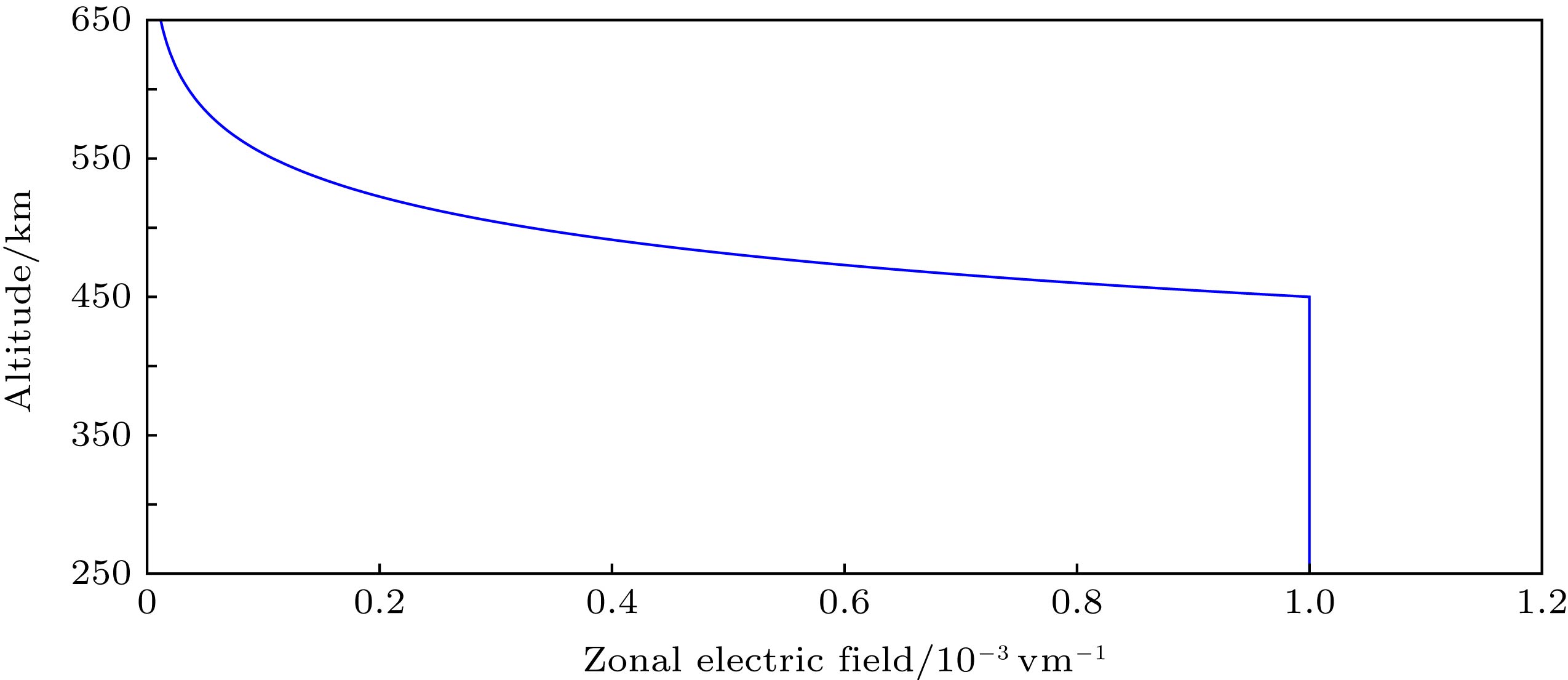
 下载:
下载:

